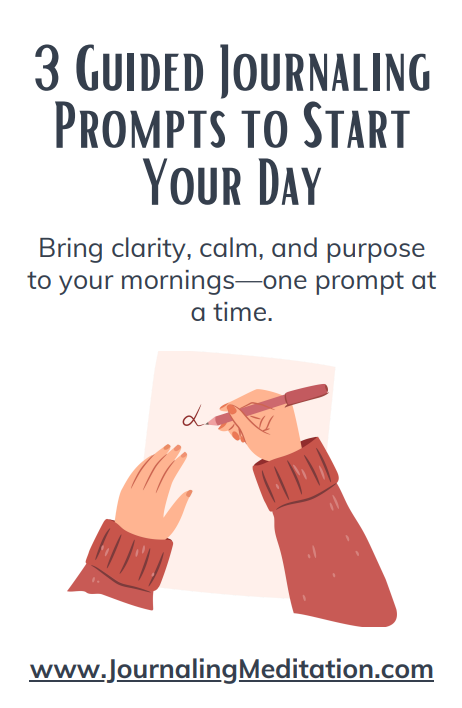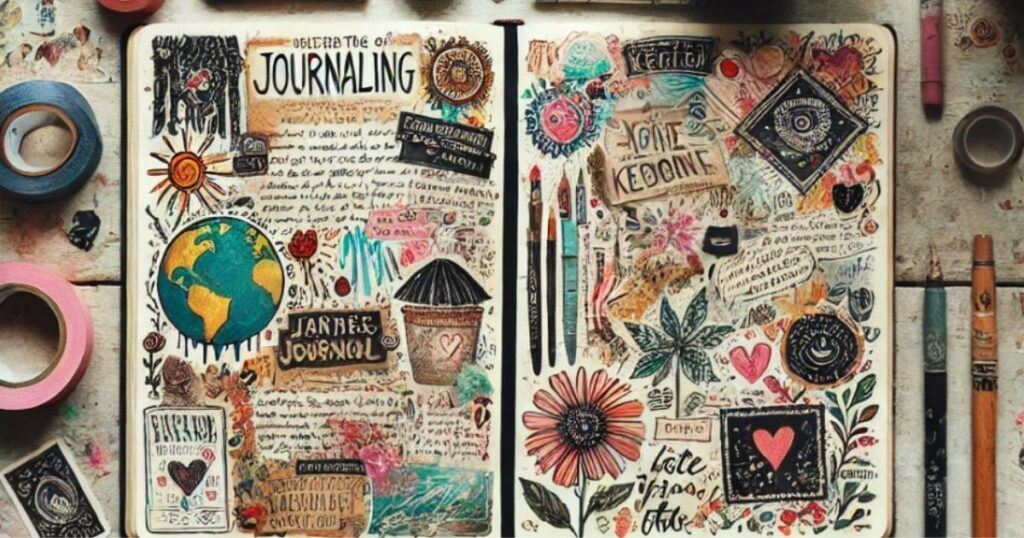
Journaling can be an extremely useful tool. It can open one up for self-discovery, expansion in mindfulness, and exploring creativity. But if you’re new to it, staring at a blank page can may catch you off guard and leave you feeling overwhelmed.
Introducing creative journaling techniques—ideas that can make the process more engaging, helping you explore your thoughts and emotions in unique ways. Whether you love words, art, or a mix of both, there’s a journaling technique to spark your creativity.
In this article, we’ll explore a variety of different creative journaling techniques, helping you find the perfect method to express yourself. No rules, no perfection—just freedom, inspiration and fun.
Start With The Right Journaling Mindset
Overcoming the Blank Page Syndrome
Many beginners struggle with starting at a blank page. The key is to shift your mindset from “What should I write?” to “What should I explore?” Instead of pressuring yourself to create something profound, start with small prompts like: “List three things that made me smile today.” You can also try one-word journaling, where you pick a random word (e.g., “growth,” “change,” “freedom”) and free-write about what it means to you.
If you’re still stuck, try timed writing—set a timer for five minutes and write anything that comes to mind, even if it’s just “I don’t know what to write.” This removes feeling the need to be perfect and can help your thoughts flow.
Choosing Your Tools & Medium
Journaling can feel more enjoyable when you use tools that inspire you. Try different notebook styles such as:
- Lined pages for structured writing.
- Blank pages for doodling and sketching.
- Dot-grid journals for creative layouts and bullet journaling.
For writing, experiment with different pens and colors—brush pens, gel pens, or even fountain pens can make the experience more expressive. If you prefer digital journaling, apps like Notion or GoodNotes allow you to create multimedia journal entries.
Creative Journaling Techniques To Try
Whether you’re new to journaling or just looking to shake things up, exploring different methods can unlock powerful insights and fresh inspiration. These creative techniques go beyond the traditional diary format, offering playful, visual, and deeply reflective ways to connect with your thoughts and emotions.
Stream-of-Consciousness Writing (Freewriting)
Freewriting is a simple but powerful journaling technique where you write without stopping for a set amount of time. The goal is to silence your inner critic and let your thoughts flow freely.
To try this:
- Set a timer for 5 minutes and write whatever comes to mind.
- Don’t worry about grammar, spelling, or making sense.
- If you get stuck, repeat the last word you wrote until a new thought emerges.
Prompt ideas:
- “Right now, I feel…”
- “Something I’ve been avoiding is…”
This method is fantastic for self-reflection and stress relief, making it a must-try for beginners.
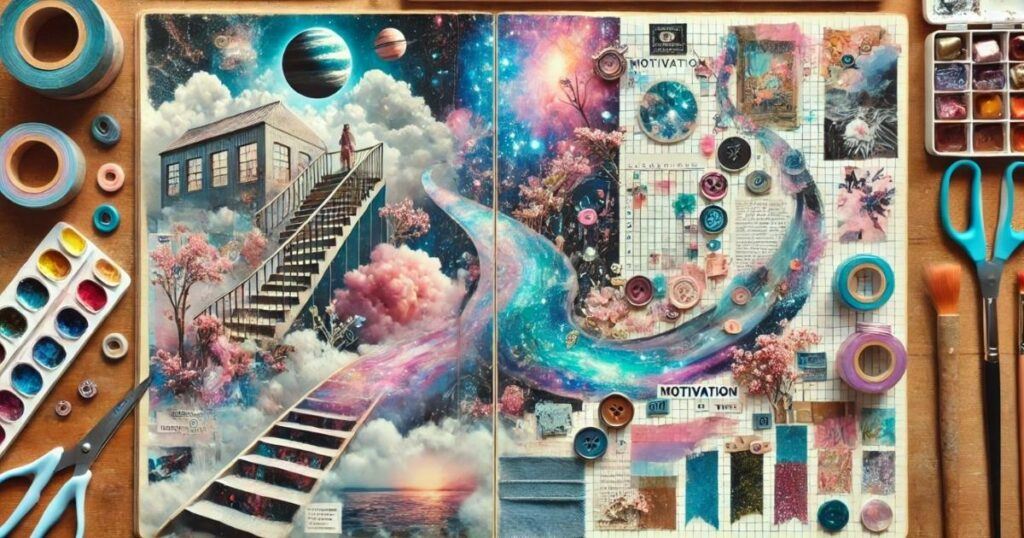
Collage & Mixed Media Journaling
Who says journaling has to be just words? Collage journaling lets you visually express emotions by making use of magazine clippings, photographs, or even fabric pieces into your journal. Washi tape, stickers, and stamps can also help add an extra flair.
If stuck, try creating:
- A vision board journal entry with pictures represent your dreams.
- A travel memory page with ticket stubs and handwritten notes about a trip.
- A mood board based on a theme like “self love” or “motivation.”
This technique can turn your journal into a scrapbook of self-expression.
Mind Mapping for Ideas
Mind mapping is a great way to visualize your thoughts to organize and explore connections between ideas. It’s perfect for brainstorming or finding clarity on a topic.
Steps to create a mind map:
- Write a main idea in the middle of your page (for example, happiness).
- Draw branches outward with related thoughts tat connect with the original idea (family, nature, music).
- Explore further by adding details or emotions connected to each branch.
Mind mapping can be extremely useful for goal setting and problem-solving.
Guided Prompts for Deeper Reflection
If you struggle with what to write, guided prompts can help. They push you to explore thoughts and emotions you may have never considered. And these prompts can be intensely focused if you wish.
Try these prompts:
- What is one lesson I’ve learned this year?
- What advice would my future self give me?
- If I had no fear, what would I do differently?
Using prompts can help strengthen self-awareness and encourage personal growth.
Art Journaling: Expressing Emotions Visually
For those who love creativity, art journaling blends drawing, painting, and writing to help you express yourself. You don’t need to be an artist—just use colors, shapes, and doodles that represent your feelings.
Try:
- Watercolor backgrounds before writing over them.
- Doodling how you feel instead of describing them in words.
- Zentangle drawing as a calming, meditative practice.
Art journaling is fantastic for stress relief and emotional processing.
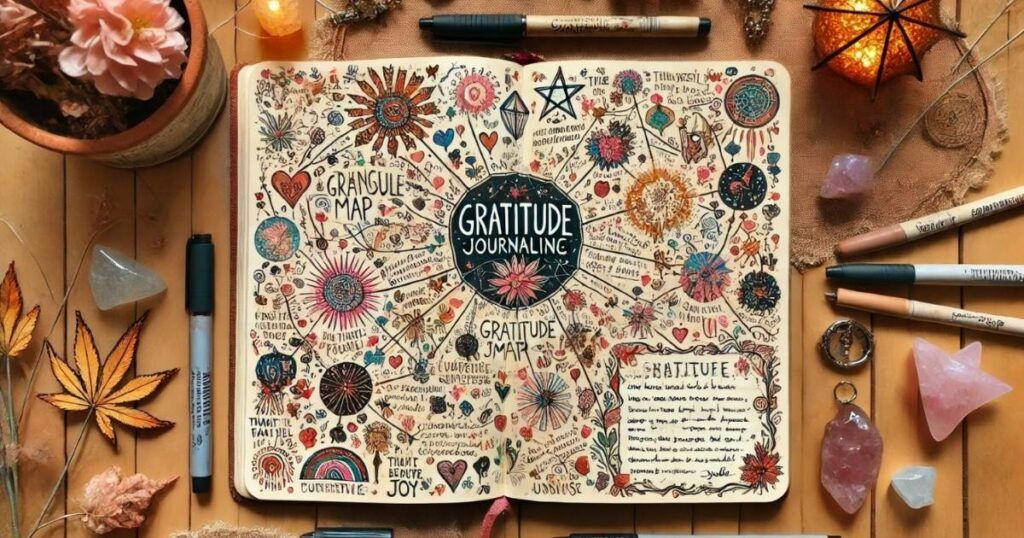
Gratitude Journaling with a Creative Twist
Instead of simply listing things you’re grateful for, try more creative approaches:
- Gratitude mapping: Draw a web of things that bring you joy and see how they connect.
- Writing a gratitude letter to yourself, a friend, or even the universe.
- Doodling or sketching symbols that represent how thankful you are.
This makes gratitude journaling more engaging and personal.
Dream Journaling for Inner Exploration
Keeping a dream journal can help you understand your subconscious mind. After waking up, jot down:
- The main theme or setting of the dream.
- Any recurring symbols (water, flying, or specific people).
- How the dream made you feel upon waking.
Over time, you may notice patterns and insights.
Making Creative Journaling a Consistent Habit
Struggling with the chore of writing in your journal every day is not going to help instill a healthy practice. But facing those issues now may help down the line:
Finding Your Journaling Rhythm
There’s no right or wrong way to journal, but consistency helps build the habit. Decide when you feel most inspired:
- Morning pages help clear your mind before the day starts.
- Evening writing allows for reflection, self-analysis and unwinding.
- Random bursts whenever inspiration strikes or you just need to get something out.
Overcoming Creative Blocks
If you feel stuck, try switching things up:
- Use a different medium (writing instead of drawing, or vice versa).
- Write a letter to your journal as if it were a friend.
- Do a “bad art” page where imperfection is the goal.
Journaling should be a fun, stress-free activity! It’s to let things out. Overthinking the process will only take away from the experience!
Final Thoughts & Encouragement
Journaling is a deeply personal practice, and there’s no wrong way to do it. Whether you prefer writing, art, or a mix of everything, experimenting with different creative journaling techniques will help you discover what resonates with you most.
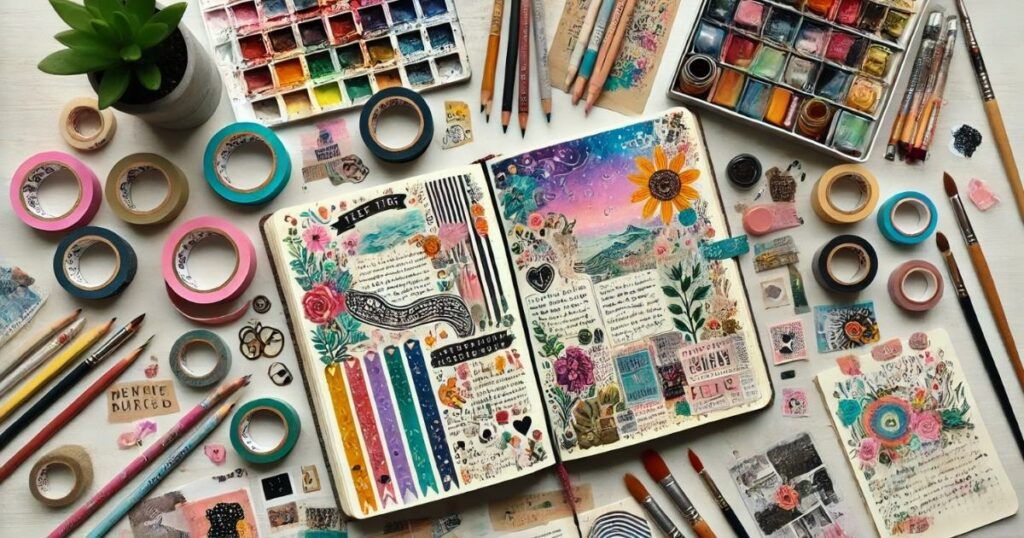
Frequently Asked Questions
Creative journaling is a flexible and powerful way to log your thoughts, emotions, and ideas. Whether you’re new to journaling or looking for fresh inspiration, these frequently asked questions will help you get started with creative journaling techniques and find the best approach for you.
How to journal creatively?
Journaling creatively means breaking free from traditional writing and experimenting with different styles. You can:
- Use collages, doodles, or watercolor backgrounds to add visual elements.
- Write in different ways like lists, poems, or letters.
- Try mind mapping or freewriting to let ideas flow. The key is to make your journal a space for self-expression, not just a record.
What is the creative journal method?
The creative journal method is a journaling approach that combines writing, art, and other forms of media to encourage self-expression. It was popularized by Lucia Capacchione, a therapist who explored creative journaling by using both words and visuals for emotional processing. This method can include:
- Drawing or painting alongside journal entries.
- Using your non-dominant hand for deeper subconscious insights.
- Include collages, stickers, and other unconventional objects into journal pages.
How to make an interesting journal?
To make your journal more enjoyable try:
- Having a theme-based journaling, such as gratitude, travel, or dream journaling.
- Using colorful pens, washi tape, and stickers for decorating.
- Including quotes, song lyrics, or pressed flowers to make each page unique. The goal is to create a journal you love flipping through!
What do I need for creative journaling?
The best part about creative journaling is that you don’t need much! Just a notebook and a pen can get you started! However, you might also enjoy using:
- Art supplies like watercolors, colored pencils, or brush pens.
- Stickers, washi tape, and decorative papers for visual interest.
- A printer for adding personal photos or inspirational images.
You see these supplies mentioned throughout this article. These props can be mixed and used together for a plethora of ideas and opportunities!
What is a junk journal?
A junk journal is a handmade journal created using recycled materials like old book pages, magazines, fabric scraps, and ephemera. Unlike traditional journals, they have a layered, textured, and artistic feel. Junk journaling is a great way to:
- Repurpose old materials into artsy, meaningful pages.
- Combine writing, scrapbooking, and doodling.
- It really does help you let go of perfection and embrace an imperfect, au natural look.
What’s YOUR Favorite Creative Journaling Technique?
Now that we’ve explored different ways to journal creatively, I’d love to hear from you! What’s your favorite creative journaling technique, or is there one from this list that you’re excited to try? Please share in the comments. I’d love to hear about your experience!





